Economic sustainability
Economic sustainability is woven into the 17 Sustainable Development Goals (SDG). Learn how the goals relate to each one.
UN Sustainable Development Goals
1: No poverty
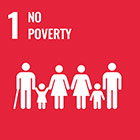
- Eliminating poverty means providing fair, inclusive, and equitable access to work, income, and/or social supports to all
- Reducing poverty improves economic stability and resilience to economic depressions or downturns
- Includes creating new jobs and work in sustainability (ex. renewable energy)
2: Zero hunger
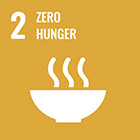
- Equitable access to a decent livelihood includes having enough to eat
- Improving sustainability in agriculture and food production helps accomplish this goal
- Includes implementing principles of circular economies to reduce food waste, create opportunities for composting and explore new or traditional food sources
3: Good health and well-being
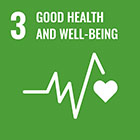
- Illness, unsupported disabilities and poor mental health result in significant costs for businesses, industry and the general economy
- Preventative care can decrease the economic burden of poor health and improve well-being
- Inclusion and accessibility strategies can bring disabled persons into the workforce
4: Quality education
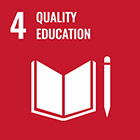
- Quality education can reduce inequalities, ensuring equitable access to secure livelihoods
- Education is necessary to build and maintain a workforce
- Lifelong learning opportunities can encourage innovation and resiliency
5: Gender equality
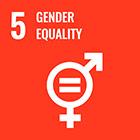
- Ensures that secure livelihoods are available to individuals of all genders
- Eliminating gender discrimination increases opportunity in the workforce and promotes innovation, entrepreneurship and productivity
6: Clean water and sanitation
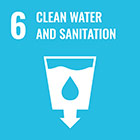
- Clean water is a necessary part of a secure livelihood, as it is necessary for life
- Sanitation improves health, reducing economic burdens associated with healthcare
- Coordinated clean water and sanitation improves resource efficiency
7: Affordable and clean energy
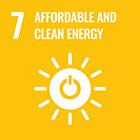
- Clean, renewable energy sources offer a new sector for economic growth
- Improving energy efficiency improves resource efficiency
- Ensuring consistent and affordable energy empowers communities and small businesses
8: Decent work and economic growth
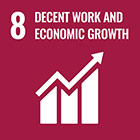
- Creating jobs that are secure, with fair wages and safe working conditions, helps ensure secure livelihoods are available to all
9: Industry, innovation, and infrastructure

- Innovation can result in new or improved sustainability of technology, production of goods, provision of services, etc.
- Involvement of and leadership by industry is essential for economic sustainability
10: Reduced inequalities
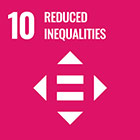
- Reducing inequalities empowers individuals and communities, increases the workforce, and increases stability and resiliency of communities and society as a whole
- Improving access to decent work for marginalized groups contributes to the reduction of inequality
11: Sustainable cities and communities

- Sustainable urban planning and development contributes to overall economic sustainability
- Cities and communities designed to include affordable housing, public transportation, and sustainable infrastructure all contribute to the goals of economic sustainability
12: Responsible consumption & production
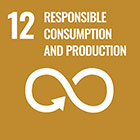
- Responsible consumption and production seek to increase resource efficiency and minimize waste
- Circular economies and circular production cycles help toward achieving this goal
13: Climate action
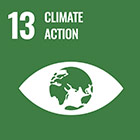
- Transitioning from fossil fuels to renewable energy decreases greenhouse gas emissions and provides new economic opportunities for innovation and job creation
- Developing climate resilient and climate adaptive systems and infrastructure likewise provide opportunities for innovation and job creation
- Economic incentives for business and industry to change their processes require government support
14: Life below water
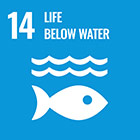
- Conservation of marine and freshwater biodiversity is essential to the long-term sustainability of industries such as fisheries and tourism, which in turn support human livelihoods and well-being
- Mismanagement of freshwater and marine resources can have significant effects on economies, human health and well-being, and the profitability and stability of businesses, industries, and communities (ex. Insufficient water for agriculture or presence of destructive invasive species such as zebra mussels)
15: Life on land
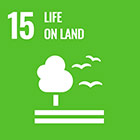
- Conservation of land-based biodiversity is essential to the long-term sustainability of industries such as agriculture, forestry, medicines, and tourism, which in turn support human livelihoods and well-being
- Mismanagement of land-based resources can have significant effects on economies, human health and well-being, and the profitability and stability of businesses, industries, and communities (ex. Soil degradation of agricultural lands or increased flood risk due to overharvesting of forests)
16: Peace, justice and strong institutions
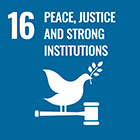
- Maintaining social stability and the reduction of crime, corruption, and injustice create a stable environment for economic systems
- Strong institutions offering equitable access support community empowerment and resiliency
17: Partnerships for the goals
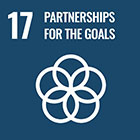
- Cooperation between communities, governments, and businesses increases economic stability and provides opportunities for efficiencies
- Global cooperation allows for monitoring and support of global economic stability and transitions to more sustainable systems or industries (ex. Phasing out fossil fuels for renewable energy)
Check your understanding
Focus on: Circular economies
In a circular economy, resources are used to make a product, and that product is made to last as long as possible through repairing, reusing, or repurposing. This increases resource efficiency and eliminates waste.
Once a product has fully exhausted its usefulness, the different parts of the product are fully recycled or composted, becoming the resources for new products, and thus decreasing the need to harvest, mine, or otherwise extract raw resources from the environment. Circular economies are based on something called “closed-loop thinking”. This means that instead of resources taking a linear path through production and use into waste, waste can also be considered a resource itself. Many producers are working towards finding uses for waste created during production.

What does a circular economy look like?
Efforts to promote circular economies can take many different forms, such as:
- Right to repair laws and legislation
- Development of more efficient and complete recycling and composting programs
- Increasing producer responsibility, which puts the financial burden of recycling products on the companies that produce them, encouraging them to create products that last longer, are made from more easily recycled or composted materials, or are more sustainable in other ways
- Building more closed-loop industries that capture waste byproducts and put them to use
- Decreasing the environmental costs of production or recycling processes by reducing carbon emissions or water use
Learn more from the Government of Canada
Developing a circular economy in New Brunswick
The government of New Brunswick has begun looking at ways to implement some of the strategies of circular economies to take advantage of the opportunities they provide. A 2023 report, A roadmap for transforming our waste into materials for tomorrow, included promoting a circular economy as one of four key pillars.
The report describes New Brunswick’s extended producer responsibility model, which “requires producers to manage and fund recycling programs for the products they put into the marketplace”.
The model encourages producers to use reusable and recyclable materials in products that are intended to stay in the economy longer (for example, products may be repairable or intended for multiple uses). This will reduce resource use, minimize waste, and decrease greenhouse gas emissions.
The extended producer responsibility model was originally introduced in 2008. The new roadmap recommends:
- Updating the provincial act that introduced this model.
- Establishing new or expanded waste diversion programs.
- Implementing two new waste diversion programs for packaging and paper products, and pharmaceutical products and medical sharps.
Strang’s Potatoes: Local example
Strang’s Potatoes found itself paying to dispose of “undersized” and “lesser grade” potatoes. It researched and then launched Blue Roof Distillers to stop sending these potatoes away and use them instead to make a mash to turn into vodka. After the distilling process, the “waste” mash is then given away to other local farmers for use as livestock feed. Instead of wasting potatoes, Strang’s was able to use circular economy principles to diversify their products, provide more value to the local economy, and build community among local farmers.
This work is licensed under a Creative Commons Attribution-NonCommercial 4.0 International License.

